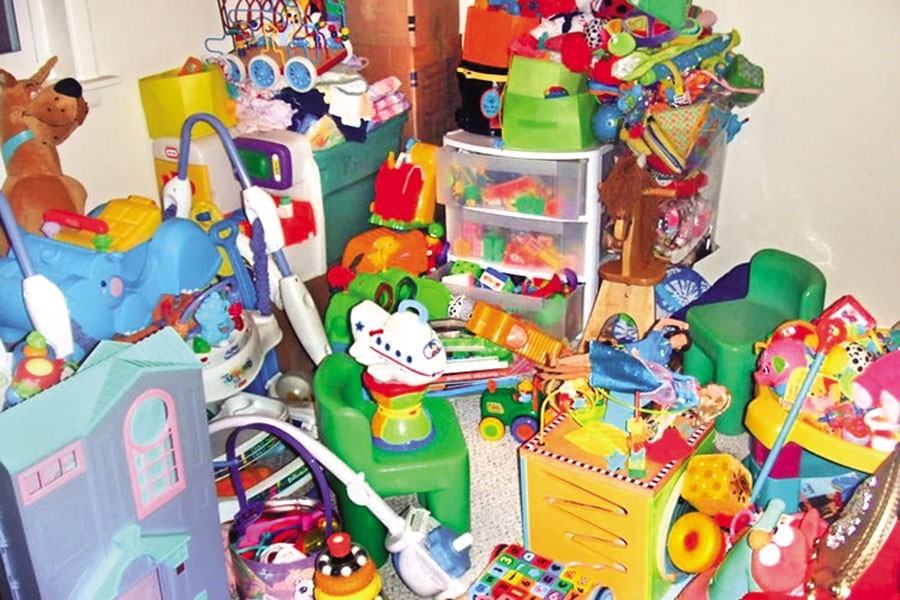
Published :
Updated :

The high level of lead in toys is exposing children to health hazards as it can be inhaled easily, experts say.
They have called for immediate research and action from the authorities concerned to address the lead poisoning.
The toxic toys can damage the central nervous system and brain function apart from serious health impacts such as learning disability, hormone problem and cancer. So, it has been identified by the US and EU regulatory agencies as a hazard for human health and environment, according to the experts.
Lead is often used in paint for decorating interior infrastructure. In plastic items, both recycled and fresh, lead is used as a modifier ingredient in order to strengthen their capacity.
It is also used in colouring, shining and brightening toys, made of both metalware and earthenware, say experts.
"Any sort of lead paint in the interior part of any home or building can have a serious physical impact on the human body, especially of a child as young as five-year-old. Lead can be inhaled from the wall paint, child toys." Prof Dr Md. Mominur Rahman of Chemical Engineering Department at BUET told the FE.
"Lead attacks the central nervous system and creates colic pain in a child's stomach. The lead mainly downs the central nervous system and create problems within the system. Pregnant mothers can be affected in the same way and it can endanger the baby in the womb disrupting the infant's proper brain development," the expert added.
"Low-end plastic, mainly made of recycled and mixed plastic, in many cases is used in toy manufacturing, and these products [toys] carry a big amount of lead. Besides, lead cadmium salt is often used in plastic pipes which we use at our water connections for buildings. They also carry a potential hazard for human health," the chemical expert mentioned.
Colourful toys usually attract children and it could be directly inhaled by a child. Children often put toys into their mouths, say experts citing a study.
"Institutional research is needed to examine whether toys available in the market are made of plastic and other materials", the chemical engineer underlined.
"We need random market sampling apart from the production unit of any company."
The state regulatory body set a standard for the use of lead paint back in 2018 with effect from 2019, pressed by environment experts. "Now we need strong regulatory measures relating to the use of lead and other toxic materials in toys and a complete ban on this lead use", said environment expert Dr Shahriar Hossain.
Still, international paint companies account for nearly 90 per cent of the market size and they claim to have been shifting away from lead paint. "If our local companies fail to bring such changes, they must lag behind others in business apart from creating physical and environmental hazards", said the Secretary General of Environment and Social Development Organisation (ESDO).
ESDO had conducted its study on the level of toxic metals' presence in the toys and the public perception in Bangladesh from October 2012 to August 2013. It showed that most of the toys contained high levels of toxic metals; including lead, mercury, cadmium, bromine and chromium.
Levels of toxic metals in 97 per cent toys tested were significantly above the EU and US-recommended ceiling of lead, cadmium, bromine and chromium. The plastic toys were the most contaminated and lead was the highest concentrated metal in different categories of toys, the study found.
Nearly 40 per cent of the toys were made of plastic and Chiba met 70 per cent of the total national demand, according to the ESDO study.
The study also found that discarded toys ended up in landfill, water bodies and drains.
Another study lately by the Stanford and icddr,b researchers raised an alarm about the presence of higher levels of lead in blood samples from pregnant women in rural Bangladesh.
The researchers have highlighted that the elevated blood lead level during pregnancy threatens mothers and their developing foetus as well as the newborn. Lead deposits in mothers' bodies are released in blood and subsequently into the breast milk, according to CDC.
"Unlike other metals, there is no safe consumption limit for lead; even small doses are toxic to the brain," the icddr,b study reads.
Having been studying international standard guidelines and acceptance level, "we have already set permissible levels of use of materials, including lead", Johura Shikder, deputy director, chemical and standards wing of Bangladesh Standards and Testing Institution (BSTI), told the FE.
"BSTI is working to set a standard toxic level for not only lead but also for all heavy metals, chemical and food ingredients. Lead standards for child toys and plastic items have also been determined to ensure a tolerable level, and the BSTI will monitor the market subsequently," she added.
The standard "we set has already been sent to the concerned ministry for approval, and we are expecting that it will come into effect within three months", the BSTI official mentioned.
nsrafsanju@gmail.com


 For all latest news, follow The Financial Express Google News channel.
For all latest news, follow The Financial Express Google News channel.